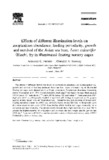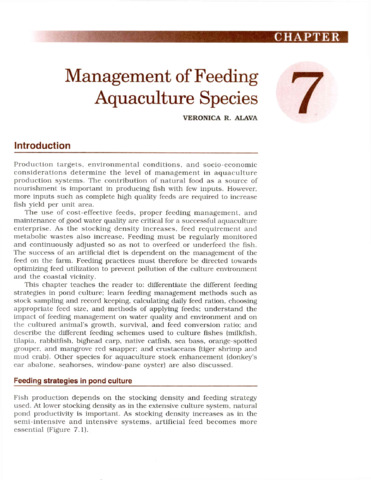Effects of different illumination levels on zooplankton abundance, feeding periodicity, growth and survival of the Asian sea bass, Lates calcarifer (Bloch), fry in illuminated floating nursery cages
- Global styles
- MLA
- Vancouver
- Elsevier - Harvard
- APA
- Help

View/
Date
1997Page views
2,198ASFA keyword
AGROVOC keyword
Taxonomic term
Metadata
Show full item record
Share
Abstract
The effects of different illumination levels on Zooplankton abundance and feeding periodicity, growth and survival of hatchery-produced Asian sea bass, Lates calcarifer, fry in illuminated floating net cages were determined in a 35-day experiment. Zooplankton abundance (consisting mainly of copepods at 64–78% of total abundance in all cages) was highest in cages illuminated at 180 lx (mean: 124 individuals l−1) and at 300 lx (mean: 405 individuals l−1) and peaked at 0400. High prey densities subsequently resulted in increased fish feeding as evidenced by the greatest number of prey (mean: 416–462 individuals fish−1) found in their guts between 0400 and 0800. Feeding incidence (range: 84–89%) was generally higher among fish held in illuminated cages than those reared in dark cages (67%). Low feeding of fish held in dark cages eventually led to starvation and mass mortality. The present results indicate that a light intensity of at least 300 lx attracts the highest number of zooplankton and promotes the best weight specific growth rate (10% day−1) and survival (40%) in sea bass juveniles reared in illuminated nursery cages.
Suggested Citation
Fermin, A. C., & Seronay, G. A. (1997). Effects of different illumination levels on zooplankton abundance, feeding periodicity, growth and survival of the Asian sea bass, Lates calcarifer (Bloch), fry in illuminated floating nursery cages. Aquaculture , 157(3-4), 227-237. https://doi.org/10.1016/S0044-8486(97)00167-1
Type
ArticleISSN
0044-8486Collections
- Journal Articles [1258]
Related items
Showing items related by title, author, creator and subject.
-
Management of feeding aquaculture species
Alava, Veronica R. (Aquaculture Department, Southeast Asian Fisheries Development Center, 2002)This chapter teaches the reader to: differentiate the different feeding strategies in pond culture; learn feeding management methods such as stock sampling and record keeping, calculating daily feed ration, choosing ... -
Use of plant protein sources in aquafeed for high value marine species in ASEAN member states
Catacutan, Mae R. (Aquaculture Department, Southeast Asian Fisheries Development Center, 2015)Cultured marine aquatic species are predominantly carnivorous. Major species in the region are seabass, grouper, snapper, tiger shrimp, mangrove crab and abalone. These species, except for abalone, require a high level of ... -
Status on development and use of alternative dietary ingredients in aquaculture feed formulations in Viet Nam
Tuan, Vu Anh (Aquaculture Department, Southeast Asian Fisheries Development Center, 2015)This paper reviewed fish catch production and estimated demand of aquafeed, fish meal, fish oil, soybean meal in Viet Nam for year 2013. Fish catch production was around 2.8 million metric tons (mt) while marine fish ...





